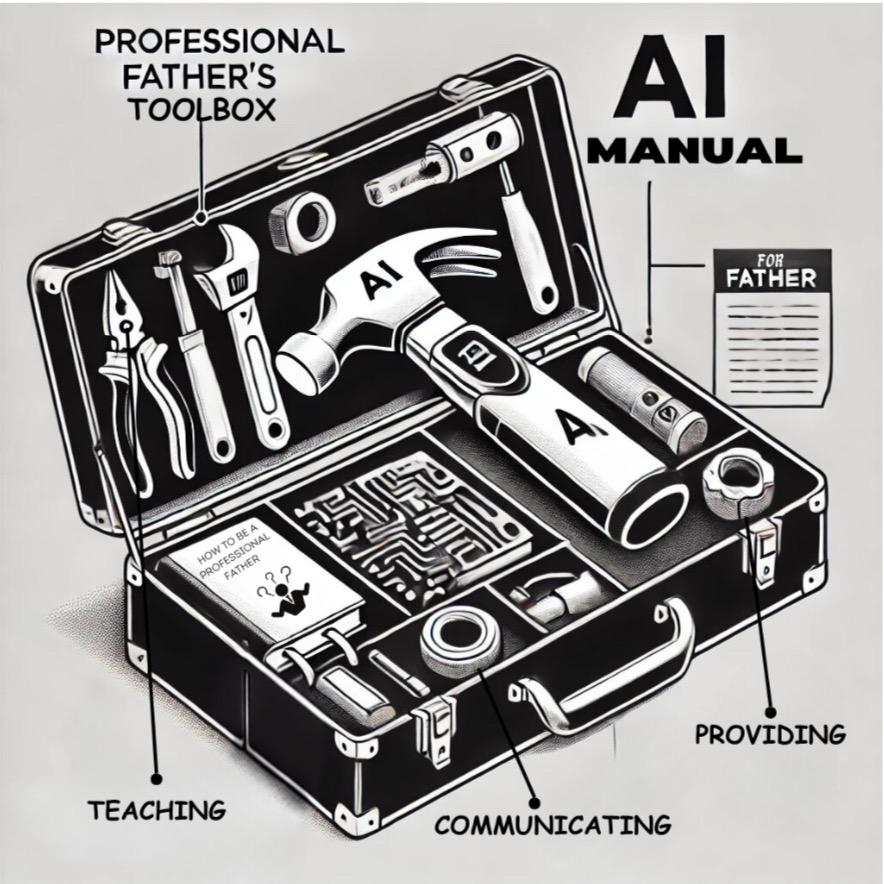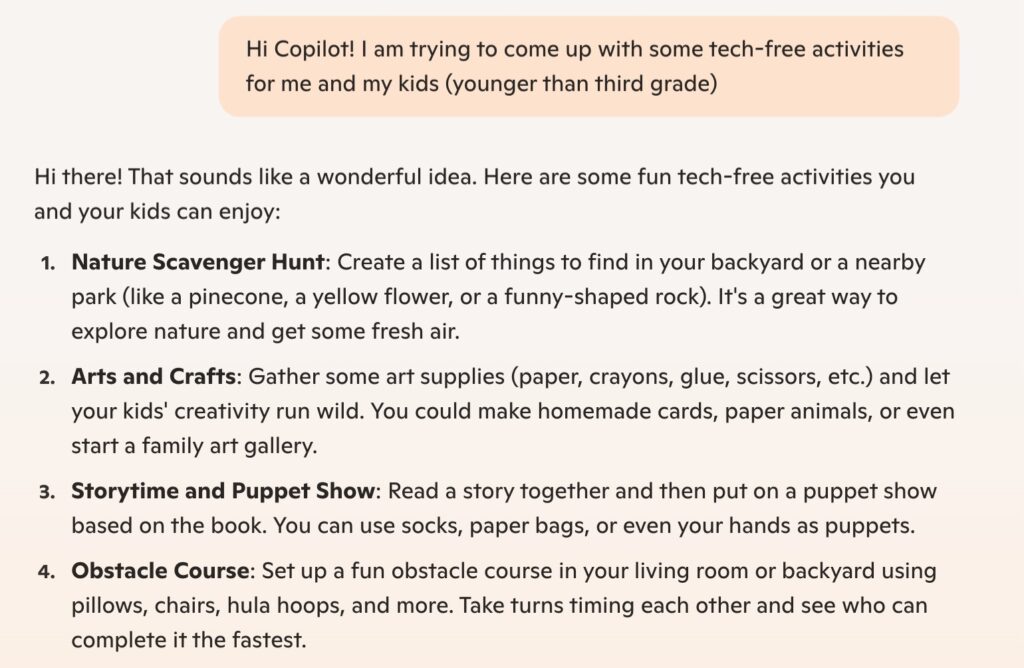Welcome to fAIther, your one-stop-shop for all things related to AI in fatherhood.
Wait, don’t go! Before you close this user manual, let’s address the AI-generated elephant in the room. We know how it sounds- why would I need technology to be a better dad? According to a recent survey, 80% of parents have interacted with chatbots, and 68% have used generative AI tools like ChatGPT.
That’s not just tech talk—it’s the reality of modern parenting. But do you really need it to be a better dad?
The raw truth is: you don’t. Dads have navigated parenting long before technology was the societal norm. AI simply isn’t the secret key to cracking the fatherhood code (if there even is one), but it can certainly be a useful tool in the process.
You don’t need a drill to put together Ikea furniture, but it speeds up the job in order to spend more time with your new decor as opposed to making it. Similarly, using Artificial Intelligence as an idea generator and supportive tool allows a father to spend more time interacting with his children as opposed to planning the activities. So grab your nearest hypothetical drill, and let’s get to building. Follow along this Faither guidebook to learn how to use this new tool to best suit your family and parenting-style!

Testing It Out:
If you haven’t had a chance to dabble in written AI (i.e. Chat GPT, Bing Copilot, Google Gemini), you’ve come to the right place. If you ask any American college student if they’ve heard of Chat GPT, you might as well have asked if they have ever used Google. Whether it’s planning workouts or brainstorming project names, students have mastered the skill of turning technology into an efficient tool. If you’re wondering how big AI’s role really is, here’s a surprising stat: The AI in Childcare and Parenting Market is projected to reach $19.06 billion by 2031, showing just how many parents are already embracing these tools.
While AI has seemingly become an integral education tool in recent years, humans have actually been using artificial intelligence for quite some time. If you have ever uttered the words “Hey Siri, what’s the weather?” or “Hey Alexa, play the Moana soundtrack”, you are already an AI pro. These devices won’t choose our outfit or write the music we listen to, but they will keep us informed to help us make better decisions. We can use written AI the same way!
Practice Exercise:
- For this practice, pull up the AI software you feel most comfortable with. (For the sake of this exercise, we will be using Bing Copilot.)
- Give the software a specific task. I stated that I was looking for tech-free activity ideas for my young kids. Here’s what it gave me:

- This is a great start, but I am in a time crunch and want to solidify a specific activity in the next few minutes. Let’s ask for more detailed ideas!
Okay, now we are getting somewhere! A conversation with AI sometimes tends to look more like a brainstorming session. You might not get exactly what you are looking for every time, and that’s okay—this tool is meant to be used as a starting point. The program has provided a list of possible activities with general rules and regulations, so now we have the freedom and the base concept to tweak these games as needed.
Feeling your inner-hacker emerge with this newfound technology skill? That’s what we are looking for- well, not the hacking, of course, but the confidence to experiment with the program! Move along to the next section of the guidebook to learn how to facilitate intentional communication with AI.
How To: Communication
Having practiced within the software, it is easy to see how the program can be used for more than just activity curation (although it is pretty efficient in that realm, as well.) Conversations with AI programs can help create ideas, plans, and insights into communicating with all members of the family. Fostering a more empathetic and supportive approach, these tools might also suggest ways to respond to tantrums, anxiety, or other emotional challenges.
A study examining AI’s impact on family communication found a statistically significant effect on accessibility and personalization, suggesting that AI can help personalize communication by analyzing data about family members’ preferences, habits, and interests.
It’s not about replacing your intuition but enhancing the moments that build trust, empathy, and connection.
While AI can certainly decode the latest trends and applicable tactics, a savvy dad might note that nothing beats a perfectly timed “dad joke” or the gut feeling honed through real-life misadventures. He would be correct. If you were to tell AI “I’m tired,” you would likely receive a response filled to the brim with ways to improve your sleep cycle. It is almost a guarantee that the program wouldn’t immediately respond with “Hi Tired, I’m Dad” unless otherwise prompted.
Do you still have your hypothetical drill handy? Imagine this tool and all its moving parts- practical and effective. When building a custom piece of furniture, a drill makes the process easier, but it is not the aspect that makes the piece unique or beautiful. That is the job of the builder or designer; AI takes on the same role as this drill. Technology can’t replace the ideas, advice, and energy that a father brings to every interaction with his child, and it’s important to keep this in mind when using AI as a relationship building tool.
Additionally, with a plethora of new games and lingo among younger generations, it can be challenging to stay up-to-speed on all the references that have made their way on the scene. For brief, real-life footnotes about a child’s current obsession, favorite show, or niche hobby, consulting AI can allow for a father to better connect with and understand their child’s interests. Take a look at the example below:
Using Roblox as an example, the program spit out possible questions to ask a child that relate to the game, ideas on how to engage in the platform further, a quick synopsis about the purpose of the program, and a reminder to talk about online safety (especially considering this is a game where users interact + chat with other players).
Not only did AI give a short “all-about-me” presentation for Roblox, but it made the user aware of possible safety concerns that a parent might not know if they weren’t familiar with the game. Using AI programs safely and responsibly can prove to be an extremely beneficial tool when it comes to conveying the value a parent holds in their child’s interests.
Setting It Up: Workplace
Now that we have practiced using AI for in-house communication, let’s take a look at its use in the workplace. While programs like Chat GPT or Copilot can certainly be used in a similar way- finding cool new icebreakers, crafting an email that needs to be sent stat, learning more about a coworker’s hobby- AI-based applications can be used to make communication and activity in the workplace more efficient. While 72% of parents worry about AI’s influence on children and teens, understanding how to integrate it responsibly makes all the difference
Of course, some might argue that relying too heavily on AI could turn us into virtual zombies constantly leaning on technology. A valid concern, it’s important to approach this type of tech as an instrument in productivity- not an end-all-be-all tool. ‘Cause hey, even the best smart assistants can’t take away the magic of a spontaneous brainstorming session or that satisfying feeling of crossing something off your to-do list the old-fashioned way.
Programs like Fathom AI act as scribe during meetings or video calls. Allowing all members to sit in on the conversation and truly engage in the presentation, the AI software takes note of everything said in the meeting, crafts a transcript based on dialogue, and condenses meeting highlights to email all participants.
Additionally, platforms like Asana use AI-based technology to improve team management. From working-style insights to AI-assisted workflow productivity, office-centered Artificial Intelligence frees up time you might spend handling administrative tasks and allows you to focus on innovation, team collaboration, and active projects. According to McKinsey, AI-driven productivity tools can save up to 20% of work hours, freeing up more energy for what truly matters—at work and home.
For professional fathers, that’s more energy to bring home after the workday.
*Want to understand how your strengths and communication style can transform both work and home life? Discover your personalized insights with a free Cloverleaf assessment designed for professional fathers. Claim your free profile here.
Expand Your Toolkit
The good news about your tool is that it is fresh to everyone- you aren’t going to become a professional AI-connoisseur in one day, and that might never be your end goal! However, learning how to use it to better enhance your day-to-day conversations can be a game changer when it comes to parent-child interaction, as well as workplace outcomes. Research indicates that AI-supported strategies can reduce employee workload, leading to better performance and more time for family interactions.
AI won’t replace your instincts, but it might just give you more energy to follow them.
Why not give AI try this week? Claim your free Cloverleaf profile here and start your journey.
Take a look at the articles below for more perspectives on AI’s role in parenting. Stay tuned for a guidebook Part II, and let us know in the comments what you think about this topic. Could you see yourself using AI as a brainstorming tool in the future?
Article 2: https://dearfathers.com/2025/01/breaking-down-the-roles-and-myths-of-ai-in-parenting/
